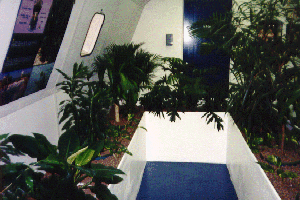|
Why Plants
Sick Building
Syndrome
 Modern homes,
for economic reasons, are designed to be highly insulated,
sealed environments. The average person
spends 90% of their life indoors in this environment. Many modern-day
synthetic materials give off toxic organic chemicals, which build up
because of the lack of ventilation. Modern homes,
for economic reasons, are designed to be highly insulated,
sealed environments. The average person
spends 90% of their life indoors in this environment. Many modern-day
synthetic materials give off toxic organic chemicals, which build up
because of the lack of ventilation.
Carpeting, furnishings, fabrics, electronic devices, glues - such items as
these emit volatile organic chemicals into the air. Chemicals such
as formaldehyde, benzene and acetone accumulate in the air. Humans also emit
gases (bioeffluents) such as methane, ammonia, xylene and alcohols.
We breathe a
mixture of all these gases in confined spaces (Indoors, pollutant
levels have been shown to be 100 times greater than normal). In the
outside world, nature cleans the air for us. Indoors, these
chemicals can build up and it is now known that these pollutants are
responsible for widespread occurence of "Sick
Building Syndrome". This has become increasingly noticeable and
significant since the early 1980's when buildings began to be
hermetically sealed to conserve energy.
Sick Building
Syndrome manifests itself in many ways, most commonly allergic
reactions, sneezing, asthma, respiratory irritations (burning eyes
and sore throats), and has been linked to cancer and "Sudden
Infant Death Syndrome" (SIDS), also known as "Cot Death".
Sources of Indoor Air
Pollution
The National
Aeronautics and Space Administration studies on indoor landscape
plants and their role in improving indoor air quality included
reports on toxins common to the interior environment, specifically
benzene, formaldehyde, and trichloroethylene.
| Pollutant |
Sources |
Effects
on Humans |
| Benzene
A
commonly used solvent, also found in fuels.
|
Inks,
oils, paints, plastics, rubber, gasoline, detergents,
pharmaceuticals, dyes, tobacco smoke and synthetic fibres. |
Skin
and eye irritation (including drying, inflammation,
blistering and dermatitis), dizziness, weakness, headache,
nausea, blurred vision, respiratory problems, tremors,
irregular heartbeat, liver and kidney damage, loss of
appetite, drowsiness, nervousness, psychological
disturbances, diseases of the blood system and
carcinogenicity. |
| Formaldehyde
A disinfectant,
preservative, and curing agent.
|
Particle
board, pressed wood, foam insulation, paper bags, waxed
papers, facial tissues, stiffeners and wrinkle resisters,
water repellents, fire retardants, binders in floor
coverings, carpet backing, permanent press clothes, natural
gas, kerosene and cigarette smoke. |
Irritation
of mucous membranes of the eyes, nose and throat, allergic
contact dermatitis, respiratory problems, eye irritation,
headaches, asthma and carcinogenicity to the throat. |
| Trichloroethylene
A
commercial product for industrial use.
|
Metal
degreasers, dry cleaners, printing inks, lacquers, varnishes
and adhesives. |
Potent
carcinogenicity to the liver. |
NASA Study shows
common plants help reduce indoor air pollution....
Common indoor
plants may provide a valuable weapon in the fight against rising
levels of indoor air pollution. Those plants in your office or home
are not only decorative, but NASA scientists are finding them to be
surprisingly useful in absorbing potentially harmful gases and
cleaning the air inside modern buildings.
NASA and the
Associated Landscape Contractors of America (ALCA) have announced
the findings of a 2-year study that suggest a sophisticated
pollution-absorbing device: the common indoor plant may provide a
natural way of helping combat "SICK BUILDING SYNDROME".
 Research
into the use of biological processes as a means of solving
environmental problems, both on Earth and in space habitats, has
been carried out for many years by Dr. Bill Wolverton, formerly a
senior research scientist at NASA's John C. Stennis Space Center,
Bay St. Louis, Miss. Research
into the use of biological processes as a means of solving
environmental problems, both on Earth and in space habitats, has
been carried out for many years by Dr. Bill Wolverton, formerly a
senior research scientist at NASA's John C. Stennis Space Center,
Bay St. Louis, Miss.
Based on
preliminary evaluations of the use of common indoor plants for
indoor air purification and revitalization, ALCA joined NASA to fund
a study using about a dozen popular varieties of ornamental plants
to determine their effectiveness in removing several key pollutants
associated with indoor air pollution. NASA research on indoor plants
has found that living plants are so efficient at absorbing
contaminants in the air that some will be launched into space as
part of the biological life support system aboard future orbiting
space stations.
While more research
is needed, Wolverton says the study has shown that common indoor
landscaping plants can remove certain pollutants from the indoor
environment. "We feel that future results will provide an even
stronger argument that common indoor landscaping plants can be a
very effective part of a system used to provide pollution free homes
and work places, " he concludes.
Each plant type was
placed in sealed, Plexiglas chambers in which chemicals were
injected. Philodendron, spider plant and the golden pothos were
labeled the most effective in removing formaldehyde molecules.
Flowering plants such as gerbera daisy and chrysanthemums were rated
superior in removing benzene from the chamber atmosphere. Other good
performers are Dracaena Massangeana, Spathiphyllum, and Golden
Pothos. "Plants take substances out of the air through the tiny
openings in their leaves," Wolverton said. "But research
in our laboratories has determined that plant leaves, roots and soil
bacteria are all important in removing trace levels of toxic vapors".
"Combining
nature with technology can increase the effectiveness of plants in
removing air pollutants," he said. "A living air cleaner
is created by combining activated carbon and a fan with a potted
plant. The roots of the plant grow right in the carbon and slowly
degrade the chemicals absorbed there," Wolverton explains.
NASA research
has consistently shown that living, green and flowering plants can
remove several toxic chemicals from the air in building interiors.
You can use plants in your home or office to improve the quality of
the air to make it a more pleasant place to live and work - where
people feel better, perform better, any enjoy life more.
NASA Study shows
common plants help reduce indoor air pollution....
How can we improve
the quality of the air that we breathe indoors - extra ventilation
is not at all a cost-effective way today ?
 The
answer has been provided by NASA. In studies designed to
discover how to purify the air for the astronauts, in their lunar
missions, in sealed spaceship environments, it was found that
certain plants effectively removed these pollutants from the air. The
answer has been provided by NASA. In studies designed to
discover how to purify the air for the astronauts, in their lunar
missions, in sealed spaceship environments, it was found that
certain plants effectively removed these pollutants from the air.
 The
work was carried out at the John C. Stennis Space Center in the
1980's. The
work was carried out at the John C. Stennis Space Center in the
1980's.
NASA constructed a
"Biohome", a tightly sealed structure, modelled on a
modern home environment.
This Biohome,
constucted of modern, synthetic materials, caused many volatile
organic chemicals (VOC's) to be emitted. Volunteers living in it
developed typical sick building symtoms such as burning eyes and
throats and breathing problems.
 After
introducing plants to the Biohome, there was a significant drop in
VOC's and the volunteers no longer experienced sick building
syndrome symtoms. After
introducing plants to the Biohome, there was a significant drop in
VOC's and the volunteers no longer experienced sick building
syndrome symtoms.
Plants also give
off water vapor (by transpiration) which increases the humidity of
the air. This is also important, as dry air damages our nose and
throat membranes and increases susceptibility to infections.
Some Benefits of
Live Indoor Plants in the Work Environment
- Plants
remove chemical toxins from indoor air - Namely the big
bad 3! Formaldehyde, benzene and TCE
|
- Plants
help reduce eye strain by providing a fresh focal point.
|
- They
provide an attractive colourful design element to business
interiors.
|
- Can
increase humidity in dry air by releasing oxygen, water
vapour, reducing static air problems.
|
- Plants
provide for a desirable psychological as well as
physiological environment by bringing some of the natural
outdoors inside
|
NASA'S
TOP 50 Air-Freshening Plants
These were found
to be the best plants for removing toxic chemicals from the air.
The Overall
Rating in the table below, is a grading based on the plant's total
performance - purifying the air , ease of maintainance, resistance to
pests and transpiration rate (How much water is released into the air - humidity
is good for us too)
The toxin
removal rating is a measure of the plants ability to remove impurities
from the air. The figures below were collected by measuring the removal of
formaldehyde (measured in micrograms per hour), a common pollutant in homes,
given off by paints, glues and fabrics.
| PLANT
NAME |
NASA
RATING |
PLANT
NAME |
NASA
RATING |
| Overall |
Toxin
removal |
Overall |
Toxin
removal |
| Boston
Fern |
7.5 |
20 |
Chinese
Evergreen |
5.3 |
7 |
| Chrysanthemum |
7.4 |
15 |
Spider
Plant |
5.4 |
7 |
| Gerbera
Daisy |
7.3 |
14 |
Banana |
5.8 |
7 |
| Pygmy
Date Palm |
7.8 |
14 |
Red
Emerald Philodendron |
7.0 |
6 |
| Janet
Craig |
7.8 |
14 |
Dumb
Cane (Camila) |
6.2 |
5 |
| Bamboo
Palm |
8.4 |
14 |
Elephant
Ear Philodendron |
6.2 |
5 |
| Kimberley
Queen Fern |
7.4 |
14 |
Golden
Pothos |
7.5 |
5 |
| Rubber
Plant |
8.0 |
12 |
Norfolk
Island Pine |
6.2 |
5 |
| English
Ivy |
7.8 |
12 |
Wax
Begonia |
6.3 |
5 |
| Weeping
Fig |
6.5 |
10 |
Prayer
Plant |
6.0 |
4 |
| Peace
Lily |
7.5 |
10 |
Oakleaf
Ivy |
5.7 |
4 |
| Areca
Palm |
8.5 |
10 |
Christmas
Cacti |
5.8 |
4 |
| Corn
Plant |
7.5 |
10 |
Lace
Tree Philodendron |
6.3 |
4 |
| Lady
Palm |
8.5 |
9 |
Arrowhead
Vine |
7.0 |
4 |
| Umbrella
Tree |
6.5 |
9 |
Heart
Leaf Philodendron |
6.3 |
4 |
| Dragon
Tree |
7.0 |
8 |
Lady
Jane |
5.3 |
4 |
| Warneckei |
7.3 |
8 |
Peacock
Plant |
5.0 |
4 |
| Lily
Turf |
5.5 |
8 |
Poinsettia |
5.1 |
4 |
| Dendrobium
Orchid |
5.5 |
8 |
Cyclamen |
4.8 |
4 |
| Dumb
Cane (Exotica) |
6.8 |
8 |
Moth
Orchid |
4.5 |
3 |
| Tulip |
4.7 |
7 |
Urn
Plant |
4.8 |
3 |
| Ficus
alii |
7.7 |
7 |
Croton |
5.3 |
3 |
| King
of Hearts |
6.0 |
7 |
Mother-in-Law's
Tongue |
6.3 |
2 |
| Parlor
Palm |
6.6 |
7 |
Aloe
vera |
5.0 |
2 |
| Azalea |
5.1 |
6 |
Kalanchoe |
4.5 |
2 |
TOP 10
plants most effective in removing:
formaldehyde, benzene, and carbon monoxide from the
air.
| Common
Name |
Scientific
Name |
| Bamboo
Palm |
Chamaedorea
Seifritzii |
| Chinese
Evergreen |
Aglaonema
Modestum |
| English
Ivy |
Hedera
Helix |
| Gerbera
Daisy |
Gerbera
Jamesonii |
| Janet
Craig |
Dracaena
"Janet Craig" |
| Marginata |
Dracaena
Marginata |
| Mass
cane/Corn Plant |
Dracaena
Massangeana |
| Mother-in-Law's
Tongue |
Sansevieria
Laurentii |
| Pot
Mum |
Chrysantheium
morifolium |
| Peace
Lily |
Spathiphyllum
"Mauna Loa" |
| Warneckii |
Dracaena
"Warneckii" |
|
